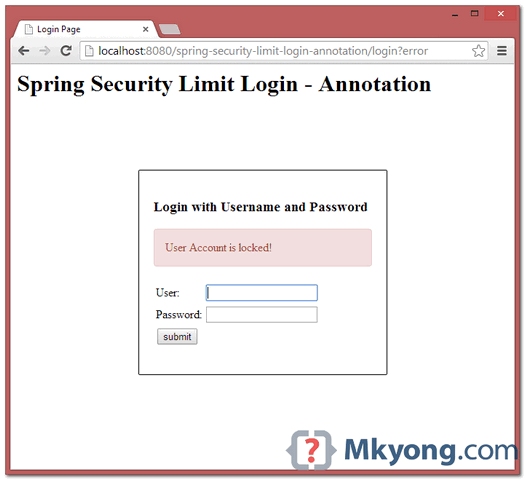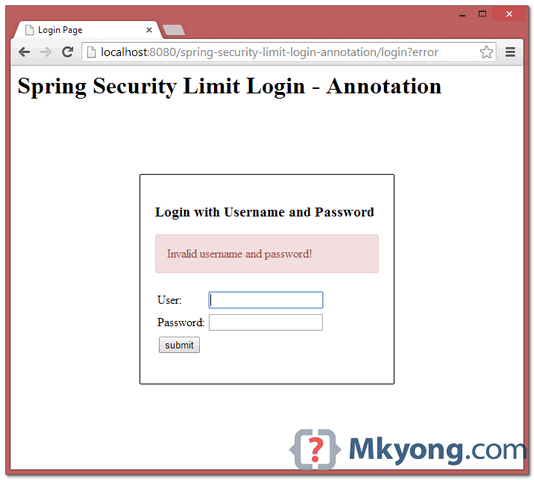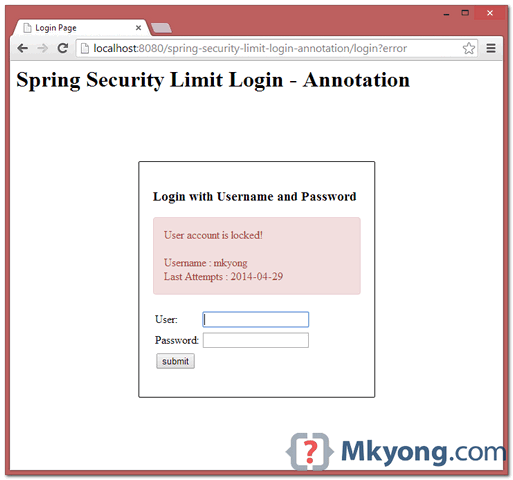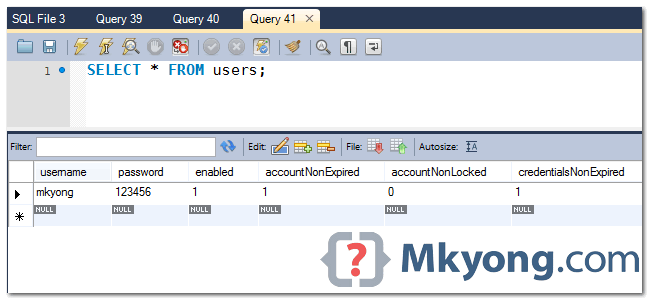Spring Security : limit login attempts example

In this tutorial, we will show you how to limit login attempts in Spring Security, which means, if a user try to login with an invalid password more than 3 times, the system will lock the user and make it unable to login anymore.
Technologies and tools used :
- Spring 3.2.8.RELEASE
- Spring Security 3.2.3.RELEASE
- Spring JDBC 3.2.3.RELEASE
- Eclipse 4.2
- JDK 1.6
- Maven 3
- MySQL Server 5.6
- Tomcat 7 (Servlet 3.x)
Some quick notes for this tutorial :
- MySQL database will be used.
- This is a Spring Security annotation-based example.
- Create a “users” table with column “accountNonLocked”.
- Create a “user_attempts” table to store the invalid login attempts.
- Spring JDBC will be used.
- Display custom error messages based on the returned exception.
- Create a customized “authenticationProvider”
1. Solution
Review the existing Spring Security’s authentication class, the “locked” feature is already implemented. To enable the limit login attempts, you need to set the UserDetails.isAccountNonLocked to false.
package org.springframework.security.authentication.dao;
public class DaoAuthenticationProvider
extends AbstractUserDetailsAuthenticationProvider {
//...
}
package org.springframework.security.authentication.dao;
public abstract class AbstractUserDetailsAuthenticationProvider
implements AuthenticationProvider, InitializingBean,
MessageSourceAware {
private class DefaultPreAuthenticationChecks implements UserDetailsChecker {
public void check(UserDetails user) {
if (!user.isAccountNonLocked()) {
logger.debug("User account is locked");
throw new LockedException(
messages.getMessage("AbstractUserDetailsAuthenticationProvider.locked",
"User account is locked"), user);
}
//...
}
}
2. Project Demo
3. Project Directory
Review the final project structure (Annotation-based):

4. Database
Here are the MySQL scripts to create the users, user_roles and user_attempts tables.
4.1 Create a “users” table, with column “accountNonLocked”.
CREATE TABLE users (
username VARCHAR(45) NOT NULL ,
password VARCHAR(45) NOT NULL ,
enabled TINYINT NOT NULL DEFAULT 1 ,
accountNonExpired TINYINT NOT NULL DEFAULT 1 ,
accountNonLocked TINYINT NOT NULL DEFAULT 1 ,
credentialsNonExpired TINYINT NOT NULL DEFAULT 1,
PRIMARY KEY (username));
4.2 Create a “user_roles” table.
CREATE TABLE user_roles (
user_role_id int(11) NOT NULL AUTO_INCREMENT,
username varchar(45) NOT NULL,
role varchar(45) NOT NULL,
PRIMARY KEY (user_role_id),
UNIQUE KEY uni_username_role (role,username),
KEY fk_username_idx (username),
CONSTRAINT fk_username FOREIGN KEY (username) REFERENCES users (username));
4.3 Create a “user_attempts” table.
CREATE TABLE user_attempts (
id int(11) NOT NULL AUTO_INCREMENT,
username varchar(45) NOT NULL,
attempts varchar(45) NOT NULL,
lastModified datetime NOT NULL,
PRIMARY KEY (id)
);
4.4 Inserts an user for testing.
INSERT INTO users(username,password,enabled)
VALUES ('mkyong','123456', true);
INSERT INTO user_roles (username, role)
VALUES ('mkyong', 'ROLE_USER');
INSERT INTO user_roles (username, role)
VALUES ('mkyong', 'ROLE_ADMIN');
5. UserAttempts Classes
This class represents the data of “user_attempts” table.
package com.mkyong.users.model;
import java.util.Date;
public class UserAttempts {
private int id;
private String username;
private int attempts;
private Date lastModified;
//getter and setter
}
6. DAO Classes
A DAO class to update the invalid login attempts, read the comments for self-explanatory.
package com.mkyong.users.dao;
import com.mkyong.users.model.UserAttempts;
public interface UserDetailsDao {
void updateFailAttempts(String username);
void resetFailAttempts(String username);
UserAttempts getUserAttempts(String username);
}
package com.mkyong.users.dao;
import java.sql.ResultSet;
import java.sql.SQLException;
import java.util.Date;
import javax.annotation.PostConstruct;
import javax.sql.DataSource;
import org.springframework.beans.factory.annotation.Autowired;
import org.springframework.dao.EmptyResultDataAccessException;
import org.springframework.jdbc.core.RowMapper;
import org.springframework.jdbc.core.support.JdbcDaoSupport;
import org.springframework.security.authentication.LockedException;
import org.springframework.stereotype.Repository;
import com.mkyong.users.model.UserAttempts;
@Repository
public class UserDetailsDaoImpl extends JdbcDaoSupport implements UserDetailsDao {
private static final String SQL_USERS_UPDATE_LOCKED = "UPDATE USERS SET accountNonLocked = ? WHERE username = ?";
private static final String SQL_USERS_COUNT = "SELECT count(*) FROM USERS WHERE username = ?";
private static final String SQL_USER_ATTEMPTS_GET = "SELECT * FROM USER_ATTEMPTS WHERE username = ?";
private static final String SQL_USER_ATTEMPTS_INSERT = "INSERT INTO USER_ATTEMPTS (USERNAME, ATTEMPTS, LASTMODIFIED) VALUES(?,?,?)";
private static final String SQL_USER_ATTEMPTS_UPDATE_ATTEMPTS = "UPDATE USER_ATTEMPTS SET attempts = attempts + 1, lastmodified = ? WHERE username = ?";
private static final String SQL_USER_ATTEMPTS_RESET_ATTEMPTS = "UPDATE USER_ATTEMPTS SET attempts = 0, lastmodified = null WHERE username = ?";
private static final int MAX_ATTEMPTS = 3;
@Autowired
private DataSource dataSource;
@PostConstruct
private void initialize() {
setDataSource(dataSource);
}
@Override
public void updateFailAttempts(String username) {
UserAttempts user = getUserAttempts(username);
if (user == null) {
if (isUserExists(username)) {
// if no record, insert a new
getJdbcTemplate().update(SQL_USER_ATTEMPTS_INSERT, new Object[] { username, 1, new Date() });
}
} else {
if (isUserExists(username)) {
// update attempts count, +1
getJdbcTemplate().update(SQL_USER_ATTEMPTS_UPDATE_ATTEMPTS, new Object[] { new Date(), username});
}
if (user.getAttempts() + 1 >= MAX_ATTEMPTS) {
// locked user
getJdbcTemplate().update(SQL_USERS_UPDATE_LOCKED, new Object[] { false, username });
// throw exception
throw new LockedException("User Account is locked!");
}
}
}
@Override
public UserAttempts getUserAttempts(String username) {
try {
UserAttempts userAttempts = getJdbcTemplate().queryForObject(SQL_USER_ATTEMPTS_GET,
new Object[] { username }, new RowMapper<UserAttempts>() {
public UserAttempts mapRow(ResultSet rs, int rowNum) throws SQLException {
UserAttempts user = new UserAttempts();
user.setId(rs.getInt("id"));
user.setUsername(rs.getString("username"));
user.setAttempts(rs.getInt("attempts"));
user.setLastModified(rs.getDate("lastModified"));
return user;
}
});
return userAttempts;
} catch (EmptyResultDataAccessException e) {
return null;
}
}
@Override
public void resetFailAttempts(String username) {
getJdbcTemplate().update(
SQL_USER_ATTEMPTS_RESET_ATTEMPTS, new Object[] { username });
}
private boolean isUserExists(String username) {
boolean result = false;
int count = getJdbcTemplate().queryForObject(
SQL_USERS_COUNT, new Object[] { username }, Integer.class);
if (count > 0) {
result = true;
}
return result;
}
}
7. UserDetailsService
By default, JdbcDaoImpl will always set accountNonLocked to true, which is not what we want. Review the source code.
package org.springframework.security.core.userdetails.jdbc;
public class JdbcDaoImpl extends JdbcDaoSupport implements UserDetailsService {
//...
protected List<UserDetails> loadUsersByUsername(String username) {
return getJdbcTemplate().query(usersByUsernameQuery, new String[] {username}, new RowMapper<UserDetails>() {
public UserDetails mapRow(ResultSet rs, int rowNum) throws SQLException {
String username = rs.getString(1);
String password = rs.getString(2);
boolean enabled = rs.getBoolean(3);
return new User(username, password, enabled, true, true, true, AuthorityUtils.NO_AUTHORITIES);
}
});
}
To save development time, you can extend the JdbcDaoImpl and override both loadUsersByUsername and createUserDetails to get the customized UserDetails.
package com.mkyong.users.service;
import java.sql.ResultSet;
import java.sql.SQLException;
import java.util.List;
import javax.annotation.PostConstruct;
import javax.sql.DataSource;
import org.springframework.beans.factory.annotation.Autowired;
import org.springframework.beans.factory.annotation.Value;
import org.springframework.jdbc.core.RowMapper;
import org.springframework.security.core.GrantedAuthority;
import org.springframework.security.core.authority.AuthorityUtils;
import org.springframework.security.core.userdetails.User;
import org.springframework.security.core.userdetails.UserDetails;
import org.springframework.security.core.userdetails.jdbc.JdbcDaoImpl;
import org.springframework.stereotype.Service;
/**
* Reference org.springframework.security.core.userdetails.jdbc.JdbcDaoImpl
*
* @author mkyong
*
*/
@Service("userDetailsService")
public class CustomUserDetailsService extends JdbcDaoImpl {
@Autowired
private DataSource dataSource;
@PostConstruct
private void initialize() {
setDataSource(dataSource);
}
@Override
@Value("select * from users where username = ?")
public void setUsersByUsernameQuery(String usersByUsernameQueryString) {
super.setUsersByUsernameQuery(usersByUsernameQueryString);
}
@Override
@Value("select username, role from user_roles where username =?")
public void setAuthoritiesByUsernameQuery(String queryString) {
super.setAuthoritiesByUsernameQuery(queryString);
}
//override to get accountNonLocked
@Override
public List<UserDetails> loadUsersByUsername(String username) {
return getJdbcTemplate().query(super.getUsersByUsernameQuery(), new String[] { username },
new RowMapper<UserDetails>() {
public UserDetails mapRow(ResultSet rs, int rowNum) throws SQLException {
String username = rs.getString("username");
String password = rs.getString("password");
boolean enabled = rs.getBoolean("enabled");
boolean accountNonExpired = rs.getBoolean("accountNonExpired");
boolean credentialsNonExpired = rs.getBoolean("credentialsNonExpired");
boolean accountNonLocked = rs.getBoolean("accountNonLocked");
return new User(username, password, enabled, accountNonExpired, credentialsNonExpired,
accountNonLocked, AuthorityUtils.NO_AUTHORITIES);
}
});
}
//override to pass accountNonLocked
@Override
public UserDetails createUserDetails(String username, UserDetails userFromUserQuery,
List<GrantedAuthority> combinedAuthorities) {
String returnUsername = userFromUserQuery.getUsername();
if (super.isUsernameBasedPrimaryKey()) {
returnUsername = username;
}
return new User(returnUsername, userFromUserQuery.getPassword(),
userFromUserQuery.isEnabled(),
userFromUserQuery.isAccountNonExpired(),
userFromUserQuery.isCredentialsNonExpired(),
userFromUserQuery.isAccountNonLocked(), combinedAuthorities);
}
}
8. DaoAuthenticationProvider
Create a custom authentication provider, for every invalid login attempts, update to user_attempts table and throws LockedException if the maximum attempts is hit.
package com.mkyong.web.handler;
import java.util.Date;
import org.springframework.beans.factory.annotation.Autowired;
import org.springframework.beans.factory.annotation.Qualifier;
import org.springframework.security.authentication.BadCredentialsException;
import org.springframework.security.authentication.LockedException;
import org.springframework.security.authentication.dao.DaoAuthenticationProvider;
import org.springframework.security.core.Authentication;
import org.springframework.security.core.AuthenticationException;
import org.springframework.security.core.userdetails.UserDetailsService;
import org.springframework.stereotype.Component;
import com.mkyong.users.dao.UserDetailsDao;
import com.mkyong.users.model.UserAttempts;
@Component("authenticationProvider")
public class LimitLoginAuthenticationProvider extends DaoAuthenticationProvider {
@Autowired
UserDetailsDao userDetailsDao;
@Autowired
@Qualifier("userDetailsService")
@Override
public void setUserDetailsService(UserDetailsService userDetailsService) {
super.setUserDetailsService(userDetailsService);
}
@Override
public Authentication authenticate(Authentication authentication)
throws AuthenticationException {
try {
Authentication auth = super.authenticate(authentication);
//if reach here, means login success, else an exception will be thrown
//reset the user_attempts
userDetailsDao.resetFailAttempts(authentication.getName());
return auth;
} catch (BadCredentialsException e) {
//invalid login, update to user_attempts
userDetailsDao.updateFailAttempts(authentication.getName());
throw e;
} catch (LockedException e){
//this user is locked!
String error = "";
UserAttempts userAttempts =
userDetailsDao.getUserAttempts(authentication.getName());
if(userAttempts!=null){
Date lastAttempts = userAttempts.getLastModified();
error = "User account is locked! <br><br>Username : "
+ authentication.getName() + "<br>Last Attempts : " + lastAttempts;
}else{
error = e.getMessage();
}
throw new LockedException(error);
}
}
}
9. Spring Controller
A standard controller class, refer to the login method, it shows you how to play around with the session value – “SPRING_SECURITY_LAST_EXCEPTION“, and customize the error message.
package com.mkyong.web.controller;
import javax.servlet.http.HttpServletRequest;
import org.springframework.security.authentication.AnonymousAuthenticationToken;
import org.springframework.security.authentication.BadCredentialsException;
import org.springframework.security.authentication.LockedException;
import org.springframework.security.core.Authentication;
import org.springframework.security.core.context.SecurityContextHolder;
import org.springframework.security.core.userdetails.UserDetails;
import org.springframework.stereotype.Controller;
import org.springframework.web.bind.annotation.RequestMapping;
import org.springframework.web.bind.annotation.RequestMethod;
import org.springframework.web.bind.annotation.RequestParam;
import org.springframework.web.servlet.ModelAndView;
@Controller
public class MainController {
@RequestMapping(value = { "/", "/welcome**" }, method = RequestMethod.GET)
public ModelAndView defaultPage() {
ModelAndView model = new ModelAndView();
model.addObject("title", "Spring Security Limit Login - Annotation");
model.addObject("message", "This is default page!");
model.setViewName("hello");
return model;
}
@RequestMapping(value = "/admin**", method = RequestMethod.GET)
public ModelAndView adminPage() {
ModelAndView model = new ModelAndView();
model.addObject("title", "Spring Security Limit Login - Annotation");
model.addObject("message", "This page is for ROLE_ADMIN only!");
model.setViewName("admin");
return model;
}
@RequestMapping(value = "/login", method = RequestMethod.GET)
public ModelAndView login(
@RequestParam(value = "error", required = false) String error,
@RequestParam(value = "logout", required = false) String logout,
HttpServletRequest request) {
ModelAndView model = new ModelAndView();
if (error != null) {
model.addObject("error",
getErrorMessage(request, "SPRING_SECURITY_LAST_EXCEPTION"));
}
if (logout != null) {
model.addObject("msg", "You've been logged out successfully.");
}
model.setViewName("login");
return model;
}
//customize the error message
private String getErrorMessage(HttpServletRequest request, String key){
Exception exception =
(Exception) request.getSession().getAttribute(key);
String error = "";
if (exception instanceof BadCredentialsException) {
error = "Invalid username and password!";
}else if(exception instanceof LockedException) {
error = exception.getMessage();
}else{
error = "Invalid username and password!";
}
return error;
}
// for 403 access denied page
@RequestMapping(value = "/403", method = RequestMethod.GET)
public ModelAndView accesssDenied() {
ModelAndView model = new ModelAndView();
// check if user is login
Authentication auth = SecurityContextHolder.getContext().getAuthentication();
if (!(auth instanceof AnonymousAuthenticationToken)) {
UserDetails userDetail = (UserDetails) auth.getPrincipal();
System.out.println(userDetail);
model.addObject("username", userDetail.getUsername());
}
model.setViewName("403");
return model;
}
}
10. Spring Security Configuration
Attached your customized authenticationProvider.
package com.mkyong.config;
import org.springframework.beans.factory.annotation.Autowired;
import org.springframework.beans.factory.annotation.Qualifier;
import org.springframework.context.annotation.Configuration;
import org.springframework.security.authentication.AuthenticationProvider;
import org.springframework.security.config.annotation.authentication.builders.AuthenticationManagerBuilder;
import org.springframework.security.config.annotation.web.builders.HttpSecurity;
import org.springframework.security.config.annotation.web.configuration.EnableWebSecurity;
import org.springframework.security.config.annotation.web.configuration.WebSecurityConfigurerAdapter;
@Configuration
@EnableWebSecurity
public class SecurityConfig extends WebSecurityConfigurerAdapter {
@Autowired
@Qualifier("authenticationProvider")
AuthenticationProvider authenticationProvider;
@Autowired
public void configureGlobal(AuthenticationManagerBuilder auth) throws Exception {
auth.authenticationProvider(authenticationProvider);
}
@Override
protected void configure(HttpSecurity http) throws Exception {
http.authorizeRequests().antMatchers("/admin/**")
.access("hasRole('ROLE_USER')").and().formLogin()
.loginPage("/login").failureUrl("/login?error")
.usernameParameter("username")
.passwordParameter("password")
.and().logout().logoutSuccessUrl("/login?logout").and().csrf();
}
}
Done.
11. Demo
Demo page – http://localhost:8080/spring-security-limit-login-annotation/admin
11.1, First invalid login attempts, a normal error message will be displayed.

11.2, If the maximum number of invalid login attempts are hit, error message “User account is locked” will be displayed.

11.3, If user in “locked” status, and still try to login again. Locked detail will be displayed.

11.4 Review the “users” table, if “accountNonLocked” = 0 or false, means this user is in locked status.

Could you write this guide using AuthenticationFailureHandler?
how to download src code becas this link is not working
spring-security-limit-login-annotation.zip
wouldn’t this allow a denial of service attack by locking all the accounts?
Only if you know all the usernames.
why any incorrect username or password cannot insert into the user_attempts table? Please help me
Excellent tutorial, but i’m having some issue with password encoder (using BCrypt), i map my WebSecurityConfigurerAdapter implementor using:
auth.userDetailsService(customUserDetailsService).passwordEncoder(new BCryptPasswordEncoder());
but when i use:
@Autowired
public void configureGlobal
the spring send me null pointer because don’t find a valid encript id.
=/
This fails to build.
[INFO] ————————————————————————
[INFO] BUILD FAILURE
[INFO] ————————————————————————
[INFO] Total time: 5.988 s
[INFO] Finished at: 2017-11-26T23:45:57-08:00
[INFO] Final Memory: 21M/69M
[INFO] ————————————————————————
[ERROR] Failed to execute goal org.apache.maven.plugins:maven-war-plugin:2.2:war (default-war) on project spring-security-limit-login-annotation: Error assembling WAR: webxml attribute is required (or pre-existing WEB-INF/web.xml if executing in update mode) -> [Help 1]
[ERROR]
[ERROR] To see the full stack trace of the errors, re-run Maven with the -e switch.
[ERROR] Re-run Maven using the -X switch to enable full debug logging.
[ERROR]
[ERROR] For more information about the errors and possible solutions, please read the following articles:
[ERROR] [Help 1] http://cwiki.apache.org/confluence/display/MAVEN/MojoExecutionException
how to encrypt username and save to database and decrypt when login is performed using rsa.
I have successfully run your project using oracle db.In addition to this ,I want to fetch roles from db dynamically without hardcode using intercept-url in security.xml.How i can achieve this.
can you do this in struts2
every works fine mk can you expalin me how this project flow…. or anyone
Thank you so much dude! You are the best
I’m using hibernate and there seems to be a problem with my transaction management because the update for the field accountNonLocked is not updated. I checked the sql query on the console and it is executed. What could be the problem
yes you are right in my case the same program i download and run firstly but first time i have not changed database password then i changed even though user_attempts tables not update do you know the reason
correct column of the table field lastModified
————————————————————————
CREATE TABLE user_attempts (
id int(11) NOT NULL AUTO_INCREMENT,
username varchar(45) NOT NULL,
attempts varchar(45) NOT NULL,
lastModified datetime,
PRIMARY KEY (id)
);
Thanks for mkyong… above program running. thanks a lot..
Why there isn’t any kind of relationship n users and user_attempts table?
Is it more easier if we user
AuthenticationFailureHandler?
Can we unlock the user through code or by firing the query on database by changing ‘accountNonLocked’ to 1 ?
Hi Mkyong, Awesome Tutorial!! I am trying to add “Password Hashing functionality” in this code by using BCryptPasswordEncoder .. Where do we actually add “encoder” reference? Could you please help in this.. I was following your password hashing tutorial. But unable to integrate here. “Please help me, what are the steps i have to take, to integrate password hashing mechanism”.
Thanks for sharing simplest yet effective examples.
Little correction on the above program. It gives sql exception when setting ‘lastmodifieddate = null’ in UserDetailsDaoImpl.java.
I had to change 2 lines of code there in the class (same db – mysql) ie.
private static final String SQL_USER_ATTEMPTS_UPDATE_ATTEMPTS = “UPDATE USER_ATTEMPTS SET attempts = attempts + 1, lastmodified = now() WHERE username = ?”;
private static final String SQL_USER_ATTEMPTS_RESET_ATTEMPTS = “UPDATE USER_ATTEMPTS SET attempts = 0, lastmodified = now() WHERE username = ?”;
really useful
getting this “Invalid username and password!” even if provide correct username and password.
In catalina.out, following is being printed.
Populated SecurityContextHolder with anonymous token: ‘org.springframework.security.authentication.AnonymousAuthenticationToken@6fabe8e0: Principal: anonymousUser; Credentials: [PROTECTED]; Authenticated: true; Details: org.springframework.security.web.authentication.WebAuthenticationDetails@fffe9938: RemoteIpAddress: 0:0:0:0:0:0:0:1; SessionId: F7A5817B451666073B753408F6713FBA; Granted Authorities: ROLE_ANONYMOUS’
Please help to solve this issue. Any help will be appreciated. Thanks in advance.
I get the same error. Please help.
Try run in debug mode (via log setting), observe on the sql output, also, make sure the database connection is correct and established.
can you please share how to unlock the account after some time
Try run in debug mode (via log setting), observe on the sql output, also, make sure the database connection is correct and established.